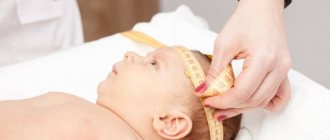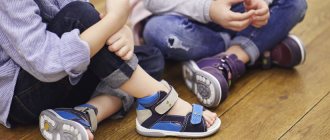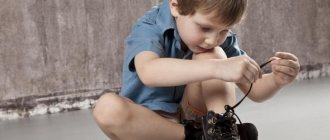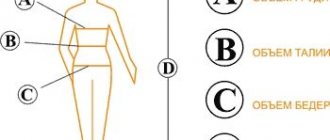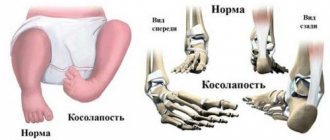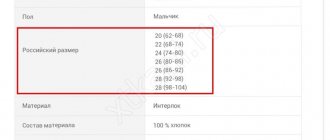The right shoes for a girl do not interfere with blood circulation and promote normal formation and growth of the foot: the child will not “shuffle”, constantly stumble and rub calluses. In shoes of the right size, the child will be comfortable, and his feet will not get tired quickly. In this article you will learn how to choose the right shoes for a girl.
Is it possible to determine a child's shoe size by age?
As you know, people of the same age can differ greatly both in height and stature, as well as in leg size. With children the situation is somewhat different. At first, children grow almost the same, and the younger they are, the faster both their height and foot length change. At the age of up to 3 years, the child’s foot increases by 2-3 sizes per year, from 3 to 6 years - by 2, after 6 years - by 1-2 annually. In order to find out the size of your baby’s feet, knowing only his age, you can use a special table.
Table of correspondence between the age of a child up to one year and foot sizes in centimeters
Since children's feet grow very quickly, children often have to buy shoes. It's no secret that shopping in search of a suitable product takes a lot of time and can be very tiring for a small child.
For this reason, many parents prefer to take measurements from their children, in this case, measure the child’s foot size by age and, leaving the kids at home with their grandparents, go shopping.
How to find out the size of a small child's feet by month, how to determine the size of children's shoes by the child's age? This article will answer these and other pressing questions.
To make children's shoes comfortable, you need to correctly determine your foot size and choose the appropriate product.
Obviously, a newly born baby does not need shoes. Socks and warm booties are used as an analogue at this age. After some time, the baby grows up and begins to walk independently. From this moment on, there is a need to wear shoes.
How to find out your child's foot size
Finding out the approximate foot size of a small child at home is not difficult at all. There are several ways to do this:
- Measure your foot using a centimeter;
- Use the classic formula;
- Apply a table of foot sizes according to the child’s age.
On a note. If a table is used to calculate the size of a child's foot, it is important to remember that each child develops individually.
Therefore, the size of the leg in each individual case may differ slightly from generally established standards, which are indicated in the size chart.
In order for new shoes to be comfortable and completely fit, it is necessary to take into account not only the length of the foot, but also the age and height of the baby.
Child foot length at different ages
If you need to determine the size of the feet of an infant who cannot yet stand firmly on his legs, then you need to do the following:
- Gently grasp the baby's foot.
- Straighten it out.
- Make sure that the baby does not curl his fingers, otherwise the result will be incorrect.
- Take a rigid ruler and measure the distance from the tip of your biggest toe to your heel (the outermost point).
- Carry out similar actions with the second leg of the one-year-old baby.
- When measuring, the largest values should be taken into account.
- Compare the result with the tabular data.
Advice. To find out the length of a child’s foot under one year old, you can use a string: it is applied to the foot in the same way as described above, then measured with a ruler and the result is recorded.
There is a classic formula for determining foot length, as well as a method for measuring fullness (height). The first option involves summing the following values:
- Foot length;
- Space for leg growth;
- Space for foot movement during movement.
The second option (by fullness) involves measuring the foot at the widest points of the toe area.
This parameter is denoted by five Latin letters: the first two characterize a thin leg, the second two – average fullness or slightly above average, the last – a full leg with a wide and high foot.
To establish the exact meaning, a half sign can be added to each letter. The next parameter differs from the previous one by 7 mm, the half-length is 3.5 mm.
On a note. The parameter for measuring the fullness of a foot on children's shoes is rarely indicated. Basically, universal shoes are produced for children without taking into account the instep. Such products have fasteners, laces, Velcro or other means of fastening. At the same time, some shoe models for the summer season provide for fullness adjustment using fasteners.
How to find out children's foot size
The easiest and most common way to determine the length of a child's foot is using a measuring tape. To do this you need to do the following:
- Prepare a sheet of paper, a pencil and a ruler.
- Ask your child to stand on a blank sheet of paper.
- The foot should be placed flat on the plane. It is important that the child does not curl his fingers.
- The foot is outlined with a pencil. Another option is to place a foot moistened with water on the paper.
- Measure the resulting silhouette or imprint with a centimeter.
- Check the resulting figure with the metric grid data and determine the size.
Important! Similar actions should be performed with the second foot. The fact is that the size of one mark is almost always larger than the second. Of the two values obtained, you need to choose the larger one.
During the measurement, you need to ensure that the child’s legs are level and the baby rests confidently and completely on his feet.
At the end of the procedure, you need to add 1/2 cm to the result (if you plan to buy summer shoes) or 1.5 cm (for winter shoes).
Thanks to this, the boots will not be too big and at the same time will fit well on feet dressed in warm socks. In addition, there will be free space for air inside, which will allow the shoes to retain heat for as long as possible.
Trace the foot to determine size
To compare foot length with shoe sizes in a store, you can cut out a stencil and apply it to the sole of the product like an insole.
On a note. It is better to take measurements in the evening, since during the day the foot is subjected to physical activity, which is why it increases slightly in size by night. In addition, blood flow improves in the evening, which also affects the length of the foot.
The foot length of a one-month-old child is determined every 3 months; in children aged 6-10 years, the foot size is determined every 5 months.
This method has several advantages:
- allows you to get the most accurate values;
- the process is easy to carry out;
- indicators do not depend on gender, specific age and height of the baby.
Important! The resulting figures cannot be rounded. You need to take into account every millimeter, then it will be almost impossible to make a mistake with the choice of suitable shoes.
How fast does the leg grow?
Child's head size by age
Children's feet grow every day, but these changes become noticeable only after a certain time. At the time of birth, the length of a newborn’s foot is about 7.5 centimeters. Subsequently, the size of the foot increases very quickly.
During the second year of life, the legs grow by 2-3 centimeters, and the feet add the same amount in the third year. The growth process stops by the age of 15, by which time the leg size is 23-26 centimeters.
In girls, growth ends earlier than in boys - at 11-14 years old, while in the latter this period can last up to 18 years.
https://www.youtube.com/watch?v=0yVrZgTC_A8
As the foot grows larger, its shape and structure also change. For each age period, certain types of shoes are selected that take into account the child’s developmental characteristics.
Table by age in centimeters
How to choose shoes for a child under 1 year old
In order for the child’s foot to develop normally, the baby must wear shoes that fit the foot size. It is important that children's shoes are not too big or too small. Otherwise, foot deformation may occur. A special table will help you determine the length of your child’s feet in relation to age.
Sizing chart for children's shoes
How to buy shoes correctly
A child tends to outgrow clothes and shoes very quickly. You should not save on shoes for a child, that is, buy products for several years at once. It is better to purchase shoes of the appropriate size with a small margin. Otherwise, in the first season it will be large, and by the next, most likely, it will be too cramped.
For children aged one to three years, shoes are chosen taking into account the following nuances:
- At this stage of development, a child’s leg grows by 2-3 cm per year;
- Measurements are taken once a month;
- During this period, shoes are worn for only one season, so it makes no sense to purchase products back to back. However, the margin should not exceed one to one and a half cm, since at this age the baby learns to walk and moves a lot, and the foot must be clearly fixed, otherwise the child will often fall.
Shoes can be selected by age only with standard height and weight indicators:
- For children aged 6-9 years, size 17 is suitable;
- For 9-12 years old – 18;
- For 12-18 years old – 19.
Products for children from 3 to 6 years old are selected in accordance with the following rules:
- Foot size increases by 2 sizes per year.
- Foot measurements are taken once every 2-3 months.
- The stock of shoes should be 0.5-1 cm. If shoes of size 25 have become tight for a child, then the recommended size of a new pair of products is 26-27. A small free space in the shoes will allow children's feet to develop normally and will not disturb their shape. Size 28 will not be suitable in this case, since this season the shoes will be frankly too big for the baby, and next year a new pair will be needed - already size 29.
- At this stage of development, boots with arch supports should only be purchased on the recommendation of a doctor.
If the child is from 6 to 10 years old, the choice of shoes depends on the following features:
- Foot size increases by 1-3 cm per year.
- Foot size determination is carried out every 3-4 months.
- At the age of 6, the child’s cartilage tissue has already hardened, and the feet acquire a clear head start and instep.
When buying children's shoes online, you need to pay attention to the following details:
- The size of the left and right legs may differ (the maximum difference is 6 mm), therefore, after measurement, both values are recorded, and the choice is made in favor of the one that is larger;
- During movement, the foot moves slightly forward. Therefore, if you wear shoes that are too tight, there will be no free space for your toes. As a result, the child will feel tight in such shoes, and walking will be difficult. The size chart for children's shoes takes into account the allowance;
- If your winter boots turn out to be too roomy, a thick wool insole will help correct the situation, which will reduce the shoes by half a size;
- You should not rely on breaking in the shoes, as the child’s feet are constantly and rapidly growing.
If you neglect the above rules, your baby may have problems of the following nature:
- When buying shoes for growth:
- The leg is not fixed when moving, which prevents normal walking, resulting in an increased risk of injury;
- Calluses appear;
- The legs get tired quickly, as during movement the muscles strain very much to keep the shoes on the foot;
- The gait becomes shuffling.
- When wearing shoes that are too tight:
- The shape of the fingers changes as they constantly bend. Walking like this has a negative impact on your posture;
- Due to the fact that the blood vessels are compressed, the legs freeze faster.
Size chart in different countries
When measuring a child's foot using a ruler, the result is a metric size (mm).
Previously, there was only one system by which the size of children's shoes was indicated in cm, equal to the length of the foot. The difference between the sizes was 5 mm. Now another system has become widespread - the non-mass system.
In this case, the size is indicated in so-called points, each of which is equal to 0.66 cm.
In Europe, foot size is determined using the stichmass system. In Russia, metric is most often used, but recently the first option is also gaining popularity.
Important! Manufacturers in different countries are guided by their own size charts (foot length can be determined in cm, inches, lengths, etc.), so when choosing a product you need to pay attention to the manufacturer and take into account the sizes according to the corresponding tables.
Country Size Chart
Signs of choosing the right shoes:
- The boots are easy to put on and take off;
- The shoes fit well, the foot is clearly fixed in it and at the same time not pinched;
- The child’s fingers should reach the toe of the shoe, but not rest against it;
- An adult's little toe can fit between the back of a shoe and a child's heel.
How to spot tight shoes
Shoes should always have a small supply. You can determine it by the insole of the product that the baby is currently wearing. You need to add a few centimeters to the length of the insole, then you will get the optimal size for the child.
To understand that the stock has been selected incorrectly, you need to pay attention to the following indicators:
- The child's shoes fit tightly;
- The arch support is not in its place (it should be located under the arch of the foot);
- Compare the model of the child’s foot with the sole of the product. To do this, place the stencil inside the shoe and determine the reserve by the heel.
You can define tight shoes like this:
How to correctly determine the size of children's shoes?
It is not enough to simply apply a ruler to the baby’s leg, since the resulting figure will not reflect the real picture. In fact, you just need to take a couple of simple measurements and you will get the child's actual shoe size.
Measuring the foot
In order to measure a child’s foot, you need to place a sheet of paper on a flat surface of the floor, fix it and place the child’s foot on the sheet so that all its weight rests on the foot.
Outline the leg, holding the pencil strictly perpendicular to the floor. Then measure the distance between the most prominent points of your big toe and heel. Instead of the described manipulations, you can use a special ruler to measure the foot , the main thing is to make sure that the baby rests on the leg being measured, because when walking, the foot expands and lengthens under the pressure of the child’s weight.
Important! Be sure to measure both feet, since one of them is a little larger, and when buying boots, be guided by a larger foot.
Errors in sizing
The most common mistake parents make is the desire to buy shoes for their child to grow into. This should never be done. Shoes that are significantly larger than the actual size of the foot are also harmful, as are those that pinch the foot.
Children's shoe sizes
It is a mistake to check if the size is correct by trying to insert a finger between the child's heel and the back. The baby can clench his fingers at this moment.
You should not try on shoes while sitting. When a person gets up and starts walking, the leg becomes a little larger. Feelings may change.
All about the fullness of shoes
Like adults, children's feet vary in fullness, and this factor is no less important when buying shoes than the length of the foot in cm . Different manufacturers may use different designations for fullness , for example, for domestic ones it is indicated in numbers from 1 to 12, with the step between adjacent fullness being 4 mm. Foreign ones use a letter designation, and the difference between adjacent measurements is 5 mm.
To calculate the fullness of shoes, there is a formula: W = 0.25B – 0.15C – A, where B is the circumference of the foot, C is the length of the foot, A is a constant value equal to 16.5 for children from 0 to 7 years and 13.5 for teenagers The circumference of the foot is measured with a measuring tape at its widest point (along the toes). For those who find calculations using formulas a difficult task, just check the foot circumference with the table:
How to navigate Aliexpress?
When buying shoes in any online store, a logical question arises: how not to make a mistake with the size? Thousands of sellers from China list their products on Aliexpress. Many of them add instructions on how to choose the right size in the product description. The translation of this instruction into Russian can sometimes be a little confusing, but most often the general meaning is clear. What they write:
If you are still not sure about your choice, when placing an order, you can write a comment to the seller indicating the length of your foot in cm and asking them to send you the appropriate size. Read the product description carefully . For example, the name of the shoes may include “genuine leather,” but the description indicates that the material of the upper and insole is leatherette.
Important! Always read product reviews; they may contain real photographs and indicate that the seller’s sizing chart does not correspond to reality.
Interesting life observation
Perhaps soon no one will be interested in the question of what shoe size it is - 27. And here's why. In the process of evolution, people gradually change. These changes are related to the growth and shoe size of humanity as a whole. For example, the average height of men at the beginning of the 19th century in Russia was only 165 cm, and women even less, about 150 cm. Accordingly, the average shoe size of the population was not the same as it is now. For men at the beginning of the 20th century it was size 41, and for women - 37. Now everything has changed: people have become taller, and their feet have grown considerably. So, currently the normal size for a girl is considered to be 39, although many already wear 41, and for men - 44 shoe size. It’s scary to imagine how this figure will change in a few more decades.
We hope that the article helped you figure it out and understand what shoe size it is - 27.
Systems for designating children's sizes and their differences
There are several size designation systems that differ from each other in the units of measurement of foot length and the reference point. The simplest of them is metric. The shoe size in this system is equal to the length of the foot, measured in centimeters .
The most common metric system is in Japan, China, and South Korea. Sometimes used by Russian manufacturers. In Europe and in most shoe stores in Russia they use the shtihmass sizing system , based on the name of the unit of measurement shtik, which is equal to 2/3 cm. Knowing the metric size in mm, it is easy to convert it to shtihmas, dividing by 6.67.
A little more difficult to determine on your own is the inch sizing system . The unit of measurement is a barleycorn equal to 1/3 inch or 8.47 mm. The peculiarity is that the countdown is not from 0, as we are used to, but from the minimum possible block. So, in England, where this system is used, the minimum last corresponding to the length of a newborn child’s foot is 4 inches, and in the USA it is even smaller.
In order to avoid complex measurements and calculations, it is enough to use special tables for matching shoe sizes from different countries.
An example of determining the size of children's shoes
Let's look at an example of how to navigate a store. Let's assume that with the correct measurement of both legs of the child you got 13.4 and 13.7 cm. Based on the larger measurement, we look for 13.7 cm in the correspondence table presented above, and see that we got a borderline size between 13.5 and 14 cm.
Remembering that shoes should not be tight, we rely on 14 cm and look at compliance with other sizing systems : these are English size 5.5, American 6.5 and European 22.5. Half European sizes are rare in stores, so we need to know in advance whether to take 22 or 23? To do this, we find out their exact measurement in cm: 22*2/3=14.67, 23*2/3=15.33, thus we got the length of the insole. As you know, the length of the insole should have a margin of about 1-1.5 cm. It turns out that if we buy summer shoes, then it is enough to take 22, and if we buy autumn or winter shoes, then 23.
The nuances of fitting
Ideally, your child should try on shoes before purchasing. But it is almost impossible to get an intelligible explanation from a child about how he feels in the shoes he is wearing. Therefore, before trying on shoes, it is best to remove the insole and place the child’s foot on it, assessing the correctness of the chosen size .
Then put on the shoes and let your child walk around the store in them for about 15 minutes . During this time, if the baby pinches somewhere, red marks will remain on the leg, and you will be able to see them. If the child feels uncomfortable during this time, he will either ask you to take off his shoes, or try to do it himself, or become capricious, which means you will need to choose a different model.
Important! It is better to go to a shoe store in the evening, when your feet swell a little and increase in size.
Tips for choosing children's shoes
Oddly enough, the ideal shoe for a small child’s feet is its absence . Therefore, whenever possible, let your child run barefoot on the grass or sand. In the city there is practically no such opportunity, and besides summer, walking without boots in our latitude is not possible. The main function of shoes is to protect the feet from cold, injury and infection. This is why it is so important to choose the right children's shoes that will not harm the child's rapidly growing feet. Recommendations:
For the first steps, it is important to choose lightweight slippers with a very flexible sole (especially in the toe area) and a soft, breathable upper that does not restrict movement. During the process of formation, the baby's legs need freedom ;- avoid pointed and narrow noses, they can lead to foot deformation;
- a small heel from 5 to 15 mm is acceptable;
- the heel of the shoe should be firm, fixing, but not very hard;
- do not buy shoes with high backs that secure the ankle; as the child grows, the ankle joint develops and strengthens naturally;
- Buy shoes strictly according to size. Please note that this does not mean end-to-end. There should be a free space of 1-1.5 cm for the toes in length. Also, do not buy shoes “for growth”; the foot in them will experience additional stress when walking ;
- choose boots with Velcro fastener, they can easily be adjusted to the desired fullness of the leg, lacing is also suitable, but it is inconvenient because the child himself will not learn to use it for a long time;
- if the child is healthy and there are no relevant indications, there is no need to wear orthopedic shoes and insoles with arch support;
- if it is not possible to take your child with you, take a cardboard pattern of the foot, which must first be placed on the outside of the shoe on the sole, and then put inside and make sure there are no jams.
How does the size of a newborn baby's foot change over the months?
Almost all children have healthy legs from birth, which will subsequently develop completely, but parents should definitely know what a limb should look like at a given age. This is extremely important, because often the legs are bent due to uncomfortable shoes, which is fraught with troubles in adulthood. So, let's take a closer look at what a child's foot should look like by month.
Peculiarities of childhood
Young children have cartilage tissue in their bodies instead of hard bones. This is provided for by nature itself, because children often injure themselves in the process of learning about the world. A child can easily fall on his buttocks and not get the slightest bruise, while for an adult such a fall can end up in the trauma department.
During the first few years, cartilage gradually forms and transforms into bone tissue. In particular, on the feet, so it is necessary to approach the choice of shoes as carefully as possible, so that in the future the incorrect development of the form does not bring suffering to the grown child.
Until a certain period, parents themselves may not even suspect such a disorder, because it manifests itself either in adolescence or in middle age. As a rule, a person with improperly constructed legs begins to periodically feel discomfort; sometimes the so-called “bones” can protrude, and in this case it becomes extremely difficult to choose shoes.
In order to prevent such problems, it is necessary to visit an orthopedist at least once a year from the age of five to make sure that the child’s legs are growing correctly and that parents have no reason to worry.
Leg by month
Young mothers should know that in the first 2 years, the length of a newborn’s leg grows by about 4 cm. In the next 2 years, it will grow by another 2.5-3 cm.
In the future, growth will occur by approximately 1 cm per year until the age of 14. Next, for another 4 years, the structure of the structure will change until it is finally established at approximately the age of 18 years.
There is a wonderful table that clearly shows what size a child’s feet are.
As you can see, the size of a child’s foot increases by literally 2.2 cm up to one year old, that is, at 12 months the baby’s foot is 11.7 cm. Subsequently, such rapid growth is no longer observed, the foot slows down in growth, and by the age of 5 it is almost equal to 18 and a half cm.
This table should not be taken as a guide. Whatever foot size your baby has, remember that all children are different and must develop independently. This is a natural process. One baby’s leg will grow by 2 cm in a year, another – by 2.5 cm, and there is no reason to worry.
Common mistakes parents make
We recommend reading: What is good about an ergo-backpack for newborns?
Experienced mothers know that the process of selecting children's shoes is a whole show, where much depends on parental intelligence and good reaction. The fact is that when choosing, little children, in principle, cannot be guided by the same criteria as adults.
The problem is not capriciousness, but the fact that babies do not immediately feel how comfortable it will be for them to walk. A child's leg still mainly consists of a layer of fat and soft cartilage, which easily bend under environmental conditions. That is, a baby can easily walk in uncomfortable shoes, not realizing what this will mean for him in the future.
Usually, when choosing shoes for a child, parents make 4 main mistakes:
- The fitting takes place this way - the mother puts the sandal/shoe on the baby and asks: “does it feel too tight?” or “doesn’t it press anywhere?” – this is a wrong approach. Naturally, the child answers negatively. He will object even if he tries on the “Spanish boot” (an instrument of torture in the Middle Ages). As mentioned above, children do not understand when shoes are tight or uncomfortable for them - their feet are still in the process of developing, therefore, the sensitivity threshold is quite low.
- Buying shoes with a cartoon character. Bright things attract children, so your little one can easily deceive you by saying that the shoes are just right for him in order to get beautiful shoes. You shouldn’t focus on children’s opinions, they are really biased.
- Fitting the shoe to the foot. This is a mistake, because the outside of the sandal can be much larger than the inside.
- Buying shoes on the fly. You can’t buy such things for children, because they grow up quickly. Within a week, your purchase will turn out to be too small, and you will have to throw it away or give it to someone else. Always buy shoes 1-2 sizes larger, in which case they will last for the season.
The foot may be damaged by wearing improperly fitted shoes.
There are several features that mothers should definitely know about. For example, when buying winter shoes, you should take into account that your foot will also have a thick sock, so you should buy such things at least 2 sizes larger.
When purchasing shoes, you should not determine its comfort by sticking two fingers into the heel. The baby will simply tighten his toes, and you will mistakenly think that the sandals will fit him.
How to buy the right shoes
The ideal option is to try on the shoes yourself at home and go shopping with the results of your measurements. In this case, you will quickly and efficiently choose an item without resorting to the baby’s opinion.
Take a blank sheet of paper and a thin marker. Carefully place the child’s foot on the piece of paper, trying to press it tightly, and trace it along the contour. It is advisable that the marker is not thick, as this may distort the result. When drawing the outline, follow your hand in a circle, otherwise the inner side will be drawn incorrectly.
The procedure should be performed in the evening hours, when the blood vessels relax and become dilated. The best time to draw is after swimming. This will help prevent you from buying tight shoes.
The measures taken will help you avoid common mistakes and choose the perfect shoes for your baby. Naturally, it is better to choose a bright, attractive thing that will pleasantly please the child, rather than something gray and shapeless. The main thing is not to buy expensive branded products, children grow quickly, and an expensive purchase will be unnecessary in a few months.
Source: https://floragaz.ru/obshee/kak-menyaetsya-razmer-nozhki-novorozhdennogo-rebenka-mesyacam
